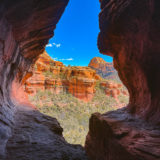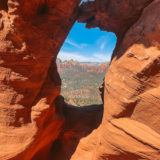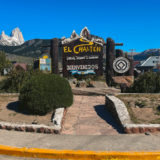10 Facts About the Santa Catalina Monastery in Arequipa

Arequipa in Peru is one of those towns where when you arrive, you say, “Man, I can live here,” and it’s true! I fell in love with so many aspects of this city. People, beautiful architecture, history, and food left a lasting impression on me. One of Arequipa’s most historically famous parts is the Santa Catalina Monastery.
This is a large monastery of the Dominican Second Order, which involves nuns taking a vow. This vow is to dedicate themselves to silence and prayer while taking on poverty.
To this day, the Santa Catalina Monastery is a symbol of Arequipa and is a must-see when visiting the city!
Some of the links in this article are affiliate links. I may earn a commission by clicking these links, which helps me create more free travel content for everyone. A win-win if you ask me!

What is the Santa Catalina Monastery?
The Santa Catalina Monastery is so massive you’ll think you’re in a different city when exploring it. It was built in 1579, and only the nuns of wealthy families could become a part of this monastery.
To become a nun here, the dowry was equivalent to $150,000 (2,400 silver pieces) in today’s money.
History of Santa Catalina Monastery
As mentioned previously, the nuns allowed to live in the monastery were rich and often a criolla. Criolla is someone who, in this case, was a white descendant of someone from Spain.
A requirement of being a nun at the Santa Catalina, they couldn’t leave the monastery. During their trial, they weren’t allowed to talk to anyone either.
Living here was a life of luxury (despite the fact they weren’t allowed to live), and it got so bad that Pope Pius IX required a reform of the entire monastery.
Santa Catalina once housed around 450 people but currently only has 20 nuns living here as I’m writing this. You’ll never see these 20 nuns as that monastery section is blocked off.

Things to Know Before Visiting Santa Catalina Monastery
If this is the first time you have heard about this attraction in Arequipa or are looking for more information about how to go on a tour, this next section is for you.
How Much Does it Cost to Enter Santa Catalina Monastery?
The price of Soles in USD can vary depending on when you plan your visit to Peru. The entry ticket is around 40 soles, which was $12 USD for us at the time.
This price might seem expensive, but it’s truly a unique place. It’s a great activity after hiking through the Colca Canyon (another popular activity near Arequipa).
I also wrote a blog about how to get to Colca Canyon if that is of interest to you.
How Much Time Do You Need Here
When I arrived, I wondered, “How much time can I spend here?”. Well, as it turned out, a lot! The monastery was 10 times larger than I had ever imagined and blew me away.
I’d say plan for at least 90 minutes to two hours. This also depends if you pay for a tour guide or not. We were able to go a little faster due to not having one.
Is It Worth It?
Absolutely! At first, I was skeptical, but I heard so much about it, so I had to take a visit. You will go back in time, and it’s an eerie yet fantastic perspective.
Make sure to go when you aren’t in a rush and have time to take it all in.
Do You Need a Guide?
We didn’t take a guide, but sometimes I wish we had. I’d suggest getting a guide if you want to learn more about the Santa Catalina Monastery.
Once inside, guides will be available for around 20 soles, and they speak many languages, so you don’t have to worry about that.
Where is it Located?
Santa Catalina Monastery is located a couple blocks from Plaza de Armas. It’s such a well-known place in the city that any taxi driver will know what you’re talking about.
And if you are staying near the main square, you’re in luck as it’ll only take a few minutes to get there.
A few cool bars near it give you a great view of the monastery and the surrounding volcanos.
Other Fun Activities in Peru

10 Facts about the Santa Catalina Monastery in Arequipa
#1 It Was Built in 1579 (Funded by a Rich Widow)
Maria de Guzman founded the monastery in 1579 as a Rich widow. The tradition then was for the 2nd child to enter a life of service. Only women who came from upper-class families were accepted.
#2 It’s Very Large, Sitting at Over 20,000 square meters
I was shocked as I was an hour into exploring the Santa Catalina Monastery, and it seemed like it never ended.
There are many rooms to walk into and even a coffee shop in the back! You can also walk up to a viewpoint of the city. Towards the end of our self-guided tour, there’s an art gallery.


#3 Dona Maria Sold All Her Belongings
Dona Maria was the founder of the monastery and a few years after it was decided it would be built, she sold everything to move into here.
She had no kids and was considered wealthy at the time. This showed she was willing to sacrifice everything for a life of solitude and dedication.
#4 The Stone Was Formed from a Volcano
Seven volcanoes surround the beautiful city of Arequipa. The most famous and one in the photos is called Volcan Misti.
Arequipa was chosen to be the location for this monastery due to the climate and the materials, like porous, formed from volcanic lava.

#5 Many Paintings Were Discovered During Restoration
Being that the monastery was so close to multiple volcanoes, earthquakes happened from time to time. Significant earthquakes in the 1960s forced a restoration project to begin.
This restoration project found over 400 new art pieces that were restored and displayed before the public opened.
#6 Sister Ana de Los Angeles Was One of the Most Respected Nuns
Sister Ana is considered one of the most dedicated and well-respected nuns of the convent of Santa Catalina. Her parents initially brought her here at three to start learning.
The plan was to keep her here until 11, but she decided to devote her life to prayer. It was said that she predicted things such as disease and death of people correctly throughout her life.


#7 The Novice Cloister is Where the Nuns Dedicated Their Lives
The novice cloister is a section of the monastery marked by a rubber tree at its entrance. This is the area where the nuns first went to if they were new for four years.
Essentially, this is where it all began for the nuns and where they decided to dedicate their lives to prayer.
#8 It Was First Opened to the Public in 1970
The monastery wasn’t always open to the public. It was completely closed off from the rest of the world for over 400 years until 1970.
This opening came after the restoration project after the 1960s earthquakes.


#9 Sister Dominga Faked Her Own Death
Many scandals and secrets were kept inside the monastery’s walls until its opening in 1970 brought everything to light.
One of the interesting stories was of Sister Dominga. Not everyone loved the religious life that was asked of the nuns. So, she decided to fake her death to get out of this situation.
#10 At the Height, More than 450 People Lived Here
At first, I thought there was no way 450 people could have lived in this monastery. But once I started walking around, it became clear that this place was so large it was almost like another world.
At the peak, 450 people lived in the Santa Catalina Monastery, which operated like its own town.


Best Places to Stay at in Arequipa, Peru
Arequipa is a fantastic city and one must visit if they have time in Peru! Below are some of the best places to stay when visiting.
- Bon Repos Boutique: This is one of the cheapest boutique hotels you’ll find, and it’s fantastic! Volcan Misti’s viewpoint seals the deal for me.
- Le Foyer Arequipa: If you’re looking for cheap, high-quality accommodation with a complimentary breakfast, then this is the place for you!
- Hotel Los Tambos Boutique: This hotel is excellent if you want a more traditional one. It’s also located in the city center, close to many attractions!
Final Thoughts on the Santa Catalina Monastery
If you are skeptical about visiting the Santa Catalina Monastery or don’t like history, don’t be. This attraction blew my expectations out of the water. If I were to return, I would find new things about this place that I didn’t know or see before. It’s that awesome! So, if you visit Arequipa in Peru, you can’t miss this spot!









